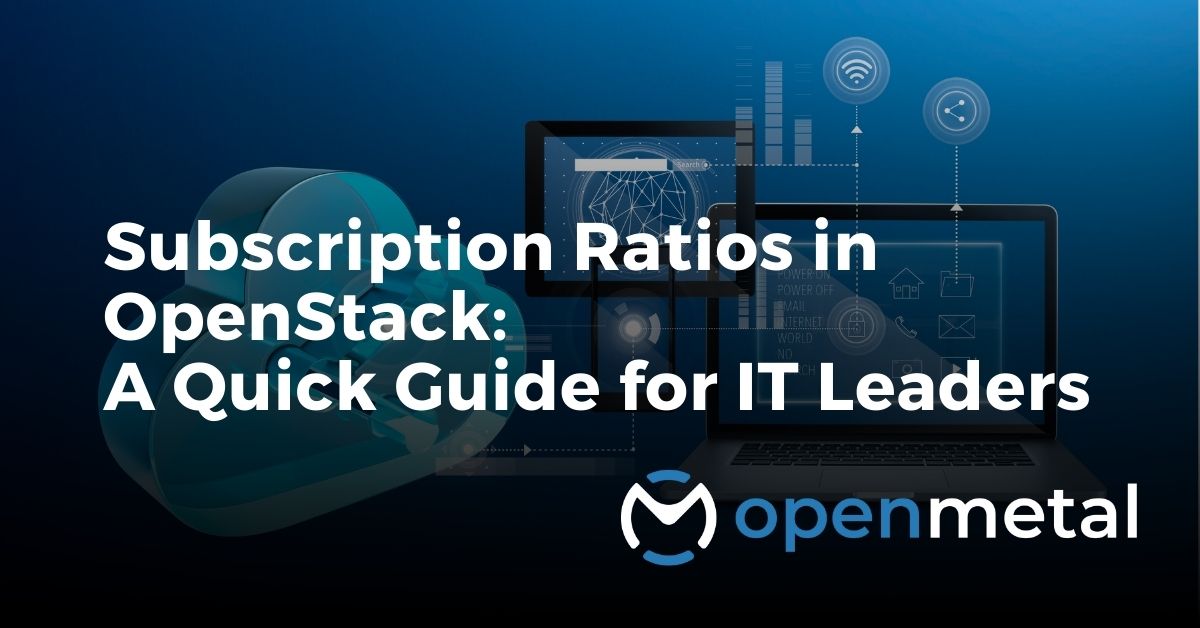OpenStack is undeniably a powerful and versatile cloud platform that many industries continue to adopt at an increasing rate. Obviously, we’re big fans! But, like any intricate technology, having a firm understanding of its inner workings is crucial for deriving maximum efficiency, especially if your business provides cloud or primarily online services. So today, we’ll be diving into the world of subscription ratios in OpenStack, which play a vital role in resource allocation across your infrastructure.
What Are Subscription Ratios in OpenStack?
OpenStack subscription ratios are essential for optimal allocation of physical resources. In essence, they determine how much capacity you can provision to virtual machines (VMs) based on how much physical capacity is available through your computes (also known as your hypervisors). By thoughtfully setting ratios, you can balance your infrastructure’s performance, workload capacity, and overall efficiency.
Subscription ratios denote the relationship between the total resources on a compute node and the actual usable capacity for instances. This concept is pivotal in resource allocation and helps us strike the perfect balance between optimizing our resources and ensuring efficient utilization.
Fun fact: The term ‘subscription ratio’ stems from the academic world, where it’s used to express the ratio between the number of students and available classroom resources.
Why Are Subscription Ratios Important?
Subscription ratios in OpenStack are important because they play a crucial role in resource allocation and management for the cloud infrastructure. They determine the relationship between the allocated virtual resources and the available physical resources in a compute node.
Optimal Resource Utilization
Subscription ratios allow IT leaders to strike the right balance between the utilization of physical resources and the performance requirements of virtual machines.
Balancing Performance and Capacity
By setting appropriate ratios, IT leaders can balance their infrastructure’s performance, workload capacity, and overall efficiency.
Avoiding Over Commitment
Understanding and setting correct subscription ratios can help prevent overcommitting resources, ensuring that workloads run smoothly without causing performance issues due to resource limitations.
Cost-Efficiency
Managing ratios effectively can lead to cost savings by efficiently utilizing physical resources and minimizing the need for additional hardware investments.
Mastering the Art of OpenStack Subscription Ratios: Tips and Best Practices
In OpenStack, there are two key ratios to consider: CPU and RAM. Understanding these ratios paves the way for better resource utilization, leading to an overall enhanced experience. It also mitigates challenges such as over commitment, thereby ensuring a seamless and stable environment for your cloud-based endeavors.
Subscription ratios are usually set for three core resources: CPU, RAM, and Disk. The default ratios in OpenStack are: CPU: 16.0, RAM: 1.5, and Disk: 0.0. Interestingly, the Disk ratio is set to zero by default since I/O performance is often harder to predict and typically configured manually based on your specific use cases.
Fun fact: The RAM ratio stems from an assumption that, on average, VMs use 66% (1/1.5) of allocated memory!
How Do You Set the Right OpenStack Subscription Ratios?
Setting the right ratios is more an art than a science. It starts with a deeper understanding of your business requirements and workloads, awareness of application behavior, and a good grasp of the physical infrastructure at hand.
To help identify the best ratios, consider the following pointers:
- Study your current workloads: Analyze peak and off-peak loads to ensure you’re provisioning for both to ensure your infrastructure runs smoothly.
- Benchmark your infrastructure: Test current and anticipated workloads under different ratios and identify bottlenecks. A well-executed trial-and-error approach will help fine-tune ratios.
- Overbooking resources: For some workloads, you may decide to overbook resources, going beyond their physical limitations. While this may save costs, it’s no secret that it could lead to performance degradation in certain scenarios. Tread carefully!
- Don’t forget to monitor: Regularly review your resource utilization and make adjustments when needed. Cloud infrastructures are dynamic in nature, and your ratios should be dynamic as well. Striking the right balance between resource allocation and performance largely depends on insightful subscription ratio management.
Wrapping Up: Subscription Ratios in OpenStack
So, there you have it, friends! By being mindful of your subscription ratios in OpenStack, you can ensure that your cloud infrastructure runs at its best capacity while delivering excellent performance. Happy cloud managing!
More on the OpenMetal Blog…

Why You Should Run Kubernetes Clusters on OpenStack
In this blog:
- Cost For Public Cloud
- Cost For Private Cloud
- Security
- Your Create Your Own Reliability.
- Kubernetes on OpenStack

What Are The Projects That Make Up OpenStack?
In this blog:
- The Projects That Make Up OpenStack?
- The Core OpenStack Projects?
- What Are Other OpenStack Projects

Kubernetes Security: Managing Clusters on OpenMetal
In this blog:
- Ops Security
- Public vs Private Clusters
- Networking
- OpenStack Security Specific Features
Test Drive
For eligible organizations, individuals, and Open Source Partners, Private Cloud Cores are free to trial. Apply today to qualify.
Subscribe
Join our community! Subscribe to our newsletter to get the latest company news, product releases, updates from partners, and more.





































